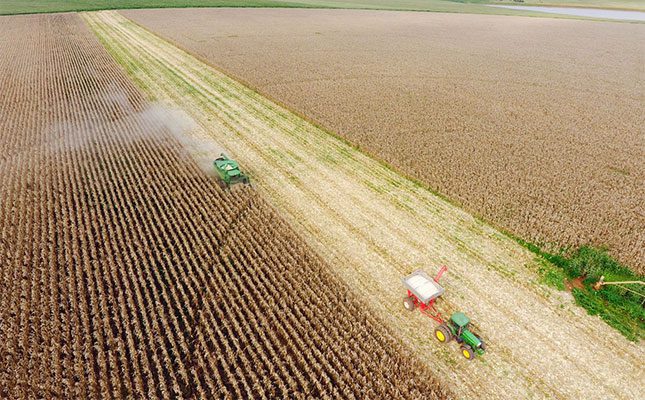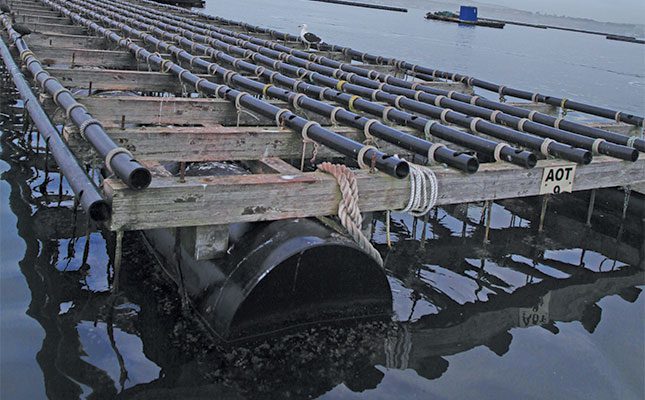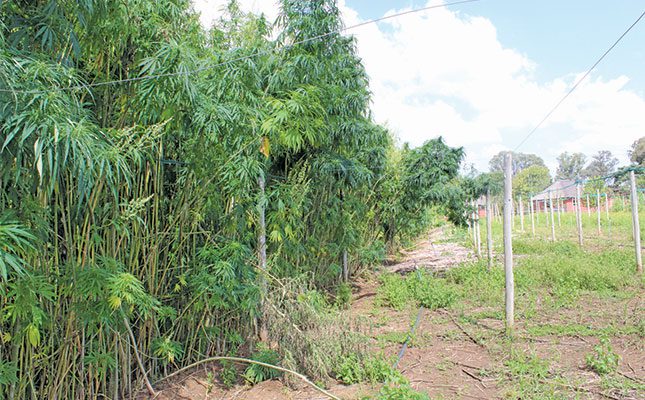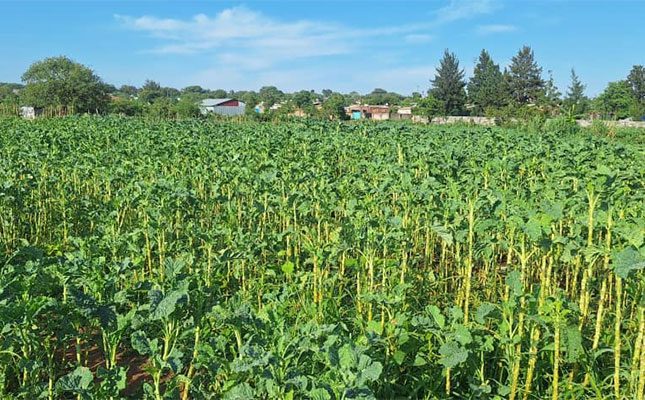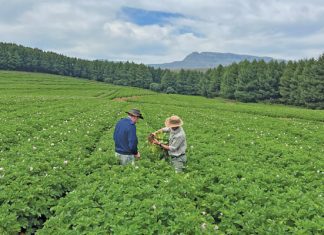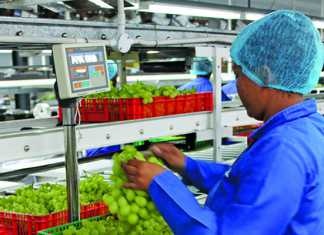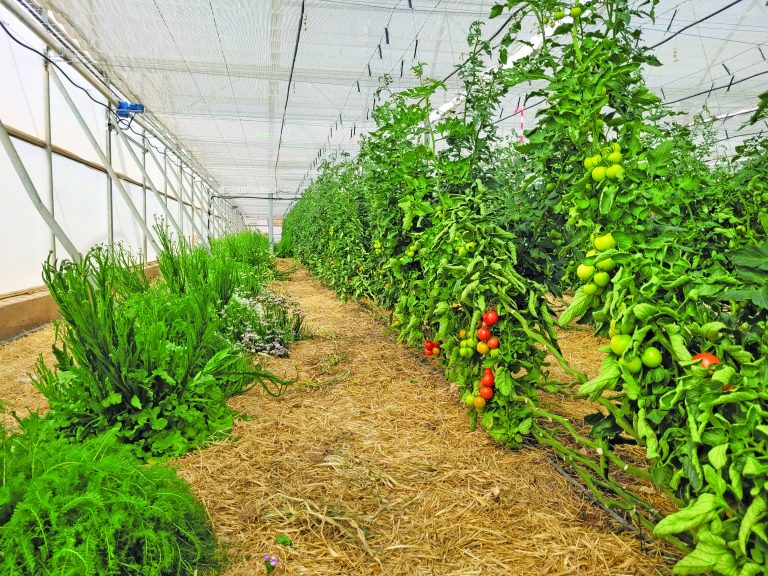
Photo: Lindi Botha
The sea of plastic – that is how the Almería region in southern Spain is mostly referred to, referencing the greenhouses that span 33 000ha.
It is indeed an awe-inspiring sight to behold, descending from over the mountain into the valley and at once having this gleaming landscape sprawled out as far as the eye can see. With the plastic sheets glistening in the morning light, one can hardly distinguish where the greenhouses end and the Mediterranean Sea starts.
The area under production makes up only 0,24% of the agricultural land in the EU. Yet its four million tons of fresh produce annually provides the union with 8% of its agricultural products, making up 24% of the EU’s horticultural production value.
Thanks to ongoing research to reduce water usage, farmers achieve this level of production using only 1,8% of the EU’s irrigation water.
These are impressive numbers, yet the area has been marred by negative publicity, most notably focusing on chemical use, exploitation of foreign workers and plastic waste, earning it an oft-used description of ‘the dirty sector’.
However, a visit to this region quickly shows a very different picture, and one that can be held up as a success story of what can be achieved when an industry stands united.
Twenty-five hives of bumblebees are needed to pollinate 1ha of tomatoes.A collective effort
A remarkable feat in Almería is that the 33 000ha of farms is owned by around 14 000 individual farmers.
This means that the spread of income is far wider than in areas where only a few players dominate the sector. Juan Carlos Pérez Mesa, economics professor at the University of Almería, explains:
“The equitable distribution of the territory results in a broad and equal distribution of the provincial economy as a whole. This means there are few disparities in terms of income levels and well-being, and population levels in this rural region are likely to remain stable, ensuring more opportunities to continue growing and supporting livelihoods.”
As far as equal representation goes, the area also boasts a high number of female participation. Some 71% of packaging and marketing employees are women, and 30% of those in production positions.
The area is also heavily reliant on foreign labourers, who mostly come from northern Africa. Around 64% of workers are immigrants, compared with 27% in other industries in Spain.
Mesa states that these workers are fully integrated into society to ensure that they keep returning to the farms, rather than seek greener pastures elsewhere.
A key pillar of Almería’s success has been collective efforts to find the best production techniques, market farmers’ produce, and solve any challenges they face. Here, farmers’ unions, research organisations, financial institutions and co-operatives have played a major role to turn this once barren landscape into Europe’s food garden.
In the 1960s, the Spanish government created incentives for farmers to move from the inland farming regions to Almería’s coast where they saw potential for agricultural production. Villages were created to provide housing for farmers and technical advice centres set up to guide production.
The harsh landscape – with summer temperatures reaching up to 42°C – meant that greenhouses quickly took off as a means to create ideal microclimates and protect crops from hail.
The ’sanding’ system was also developed where crops are grown in mixtures of soil and compost, with a thick layer of sand on top to prevent moisture evaporation.
The area’s limited water supply, which mostly comes from boreholes and melted snow from the mountains, means that greenhouses are even more attractive since they reduce water requirements by up to 20%.
Once production became successful, co-operatives were set up to pool produce and market it collectively to ensure continuous supply to the market.
Today, 60% of produce is sold through co-operatives, who also assist with technical production advice based on market demands, and the rest is sold on auction.
Test stations were set up to continuously improve production techniques, and still form a vital part of the area’s success today. In any given year, around 500 different tomato cultivars are being trialled, for example, with one successful candidate commercialised every five years. There are around 100 different varieties of tomatoes grown in Almería.
Tomatoes were once the largest commodity grown in Almería, but due to increasing competition from countries like Morocco, only make up 20% of the produce today. Sweet peppers take up a 25% share, cucumbers 14%, and watermelons 14%. Spain absorbs 50% of the produce, with the rest being exported, mostly to the EU.
Getting such a large group of farmers to work together in pursuit of mutually beneficial goals has been the foundation of the region’s success.
It’s this co-operation that led to the complete turnaround of the industry from one that was heavily reliant on chemical crop protection, and quickly becoming redundant, to one of the greenest produce hubs in the world.
Fresh produce exports from Almería had been steadily increasing, with sweet peppers exports to Germany, their largest export market, reaching 130 000t in 2004. At that stage, the industry relied solely on chemical pesticides for crop control.
Breaking the chemical cycle
Growers started seeing efficacy rates dip as pests developed resistance to the active ingredients, with the result that applications were increased. The inevitable result was that produce was not meeting maximum residues levels (MRL) prescribed for the chemicals, and markets started to notice.
Jan van der Blom, head of technical production at farmers’ union Coexphal in Almería, relates how sweet pepper exports to Germany were halved as a result. It was a wake-up call to the whole industry, which then readily turned to biological crop production.
“Biological crop protection would never have worked in an area as dense as Almería if every farmer was not on board, because chemicals from one farm could easily spread to another and kill any beneficial insects released. Fortunately, it was not hard to convince the farmers to comply because we had the research to back it up, and they realised they would be out of business if they didn’t comply,” says Van der Blom.
At that stage, thrips showed total resistance to insecticides and farmers were suffering large losses. Pollination on tomato crops was also proving to be expensive since honeybees avoided their flowers as they didn’t contain nectar.
Pollination therefore had to be done mechanically and by hand, a time-consuming and expensive exercise.
One of the first companies to develop biological crop protection for Spanish farmers was Agrobio. Situated at the centre of the ‘plastic sea’, they breed indigenous predatory insects, bacteria and fungi that fight a host of pests in Almería’s greenhouses.
Their research has played a significant role in the success of biological crop protection, which has meant that produce in Almería went from 35% receiving MRL violations in 2007 to zero today.
In 2007, 60% of MRLs were at acceptable levels, but no produce was residue free. Today, 94% is within accepted MRL levels and the remaining 6% is residue free.
Sweet pepper exports to Germany have consequently recovered, and the value of these exports increased by 10% from 2004 levels, now earning €310 million (about R6,2 billion) in income for the region per year.
Isabel Mendizabal, agricultural engineer at Agrobio, explains that typically, farmers would use up to six different species of beneficial insects to obtain control over pests.
“While this can only reduce damage by up to 90%, the 10% damage is acceptable to farmers since it allows them to maintain market access.”
The dreaded Tuta absoluta moth, which is currently decimating tomato crops in South Africa, reached Spanish farms in 2009.
Mendizabal says farmers initially turned to pesticides once more, but Agrobio soon found an indigenous insect, Macrolophus pygmaeus, which feeds on the moths’ eggs, reducing the damage caused by moths by 80%.
To solve the pollination problem in tomatoes, Agrobio turned to bumblebees.
“Honeybees have a good communication system and if they realise there is no nectar to be found where they are, they will go back to the hive and ‘tell’ the others to stay put and not waste their energy. Bumblebees are not so smart,” smiles Mendizabal.
“They will keep going from flower to flower looking for nectar and in the process pollinate the flowers. To keep them fed, we provide a nectar solution for them in the greenhouses.”
To pollinate 1ha of tomatoes, 25 hives are needed, containing 100 bumblebees each. Of course, using pesticides then becomes unviable and Mendizabal explains that the bumblebees were therefore very much a catalyst for greater biological production uptake.
An added bonus of using bumblebees is that they are far better at pollinating tomatoes than humans or machines, and since their introduction, farmers get more uniformity in the shape and ripening of the tomatoes.
An important part of creating a thriving environment for beneficial insects is providing them with alternative food sources and havens in the greenhouses.
These banker plants, as Mendizabal refers to them, are indigenous shrubs and flowers grown on the edges of the tunnels. She notes that the biodiversity created in the tunnels have meant that 54% of growers have reported the presence of beneficial insects that they did not release themselves.
Research is ongoing to find the best combination of flora to include in the greenhouses so that the beneficial insects have the most optimal habitat in which to work.
“The greater care you take to provide for the primary needs of the insects, the more energy they can spend on fighting pests,” says Mendizabal.
Pest control in Almería is however not a perfect science. Mendizabal notes that climate change is impacting the range of pests in the tunnels.
“We are seeing an increase in pest activity as the climate warms. The period during which control is needed has also lengthened. This means we need to work harder at finding more natural solutions, and ways to keep our beneficial insects working optimally for us. Going back to pesticides can never be an option, especially since more and more products are being removed from the market every year.”
She also points to the many benefits growers have seen since switching to biological control: those working in the tunnels are no longer exposed to chemicals, growers have control right up until harvest, and more markets have opened to them.
Focusing on plastic
The mass of plastic used in tunnel production in Almería is one of the main criticisms of the region by the environmentally conscious. But this too has been largely addressed.
Van der Blom explains that while a lot of plastic is needed for tunnel production – around 9g per kilogram of tomatoes – it is also a crucial part of sustainable production.
“The translucent covers capture all the sun and heat, and protect crops from intense cold and rain. As a result, Almería does not require any heating to produce vegetables and fruit in winter. Water evaporation is minimised, so our water footprint is lower. By using winds from the east and west, we can cool the temperatures inside the tunnels so that they never exceed 30°C. We can keep humidity under control and create a perfect microclimate for optimal production of high-quality produce.”
The irony of the sea of plastic is that the light reflection that happens as a result of the white surfaces has resulted in an albedo effect.
This happens when light is deflected rather than absorbed as would be the case if the land was bare, resulting in a cooling of the atmosphere. Almería has consequently seen a 1°C reduction in average temperature over the past few decades, reducing the effect of global warming.
Furthermore, each hectare of solar greenhouse absorbs 10t of CO2 per year, which is equivalent to the emissions of eight cars.
Production takes place from September to June, with the peak of summer providing an opportunity for the soils to rest. Competition from other production regions is also high during this time, which means summer cultivation is not worthwhile for the Almeríans.
And as for the plastic pollution, the industry has been working on a solution, achieving an 80% recycling rate across all plastics used for crop production in the area.
Mesa notes that 100% of the plastic tunnel covers are recycled, but that other items like large fertiliser containers are more difficult to recycle. The recycled plastic is made into granules, which are then used to produce other plastic products.
Almería’s environmental efforts have paid off, and Van der Blom states that over the past few years, populations of owls, flamingos, lizards and chameleons, to name a few, have been increasing.
“This is proof that our strategy is working. I believe that Almería can be an example of how an industry can work together to achieve sustainability for all.”
Plastic sheets are used to keep the soil covered to reduce moisture evaporation and to suppress weeds.Changing perceptions
Despite the fact that 80% of Almería’s plastic is recycled, and that over the past 20 years pest control has been 80% biological, negative consumer perceptions have persisted.
This demonstrates how difficult it can be to get consumers to change their minds once an idea has taken hold.
The Spanish Interprofessional Organisation of Fruits and Vegetables, Hortiespaña, therefore launched a three-year marketing programme last year to promote the benefits of horticulture under solar greenhouses in Southern Europe.
This is aimed at consumers who are looking for quality products, and are aware of environmental issues and concerned for food security.
Key goals of the campaign are to increase the perception of produce grown in greenhouses as sustainable products, and increase consumption of produce grown in greenhouses.
Messaging will also include showcasing tunnel production as being efficient in terms of environmental, social and economic sustainability.
The story of Almería provides a useful glimpse into what can be achieved when agriculture is supported at all levels of the value chain. It proves the often quoted wisdom that if you want to go fast, you go alone, but if you want to go far, you go together.
Email Isabel Mendizabal at [email protected].

